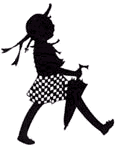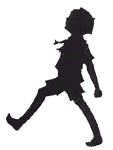
|
HELPING ROSA
|

|
|
|
Article 1 Reading Problems |
Article 2 Helping Rosa |
Article 3 Working With Tony |
Article 4 Inexpensive Teaching Materials |
(The following article was written by Patsy (Smith) Stevens in 1978 and published in a paper concerning the education of children with learning disabilities.) About the Author
Filmstrips, projectors, cassettes, tape recorders, and other such teaching aids are great, and we use them extensively in the resource room. But the time comes when the right filmstrip or taped lesson is just not available to teach a particular child a certain concept. This is the time for the creative teacher to use his or her ingenuity and make what is neded for that child.
One of our most valuable teaching aids has been a box of crayons and a roll of unprinted newsprint paper.
Many newspapers throughout the country make these rolls of unprinted newsprint (rolls eight to ten inches in diameter which are too small for them to use) available at a minimal cost to schools or organizations that perform a public service.
The two case histories which follow give you examples of various ways to use newsprint in the classroom.
Rosa*, one of our first grade children, after a year in kindergarten and 5 1/2 months in first grade, still knew only half the letters of the alphabet, and in some cases could make only either the lower case or the capital letter. She wasn't reading at all and had difficulty with math concepts. Although she was of Mexican-American descent, her language was English dominant. According to the diagnostic report she was a visual learner. We decided to place her in the resource room for 30 minutes a day in a one-to-one arrangement.
Our goal for Rosa was that by the end of the year she would be able to recognize and print all the letters of the alphabet, and know the sounds of the 26 letters and the digraphs sh, th, wh, and ch.
We worked for two or three days on each letter and we did not introduce "b" and "d" together because she was already confusing the two letters. To help her differentiate b's from d's I showed her how you could make a capital B and erase the top circle of the letter to change it into a lower case b. She practiced writing the letters on the newsprint.
On the second and third days of working on a letter, Rosa would match two pictures that began with that letter to a card on which the letter was written. The pictures were pasted on newsprint. (See photo above) She also did some worksheets on which she had to circle pictures and write beginning letters.
In 15 weeks she could match the pictures with the correct beginning letters of all the consonants except "w", and she could also write all the letters of the alphabet, upper and lower case as they were dictated to her. She did not learn the digraphs.
In addition to the alphabet, we also worked on writing numerals to 100 in two-inch squares on newsprint, recognizing these numerals, and working addition and subtraction problems involving combinations up to 10.
Sometimes a math game was made on the back of the work page for her to play with a classmate when she returned to her classroom.
(Rosa was retained in first grade the following year.) * The name of the student has been changed.